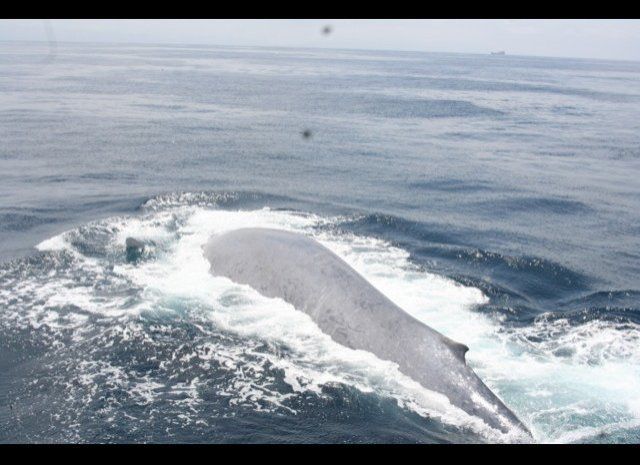There's still time to see one of the greatest shows on Earth. And it's not far, particularly if you live near Long Beach, CA (or another ocean-front city).
The largest animal on the planet, the Blue Whale, is frolicking, literally, in the waters off Southern California right now and Captain Dan Salas, owner of Harbor Breeze Cruises, couldn't be more excited. But it's not just the increased business the whales bring. It's the excitement.
"There's nothing like seeing these animals up close. It's so humbling," he started to explain as we headed out of the Long Beach Harbor on an afternoon cruise. "And it reminds us that we aren't the biggest, baddest thing out there," he added.
Going on a harbor cruise, from Harbor Breeze or any other, is part entertainment part field trip. On the way out, a biologist from the Aquarium of the Pacific in Long Beach, CA takes time to point out the various bird life, the giant sunfish and their relationship with the birds (they surface so the birds can eat parasites off of them, they get clean, birds get fed); the harbor seals, the dolphins that mirror the boat. Right here in one of the busiest ports in the world, some of the greatest creatures on the planet feed and play for all to see.
"There's nothing like seeing that blue flash near the boat," Salas continued. "That bright flash and then that spray, the spray that goes up at least 40 feet, it's just awe inspiring." The blue to which he refers is how the Blue Whale got its name. Prior to surfacing, the whales begin to come up, and as they do their body flashes a bright blue under the water -- a long, sometimes 80 or 100 foot streak that signals these giants are about to surface. Blue whales don't typically fluke, where their tales come out of the water, particularly when feeding.
"Once you see the blue, you look for the spray. These whales are feeding on the krill that are here because of the cold water uprising from our deep canyons off shore of Long Beach and Los Angeles, all along the Coast of California and in many waters around the world where all types of whales live," Salas continued.
About 45 minutes in to our cruise... there they blow! Our boat of about 150 diverse individuals grows silent; completely quiet. Our staff, with expert whale watchers and navigators who have been doing this for decades, have spotted not one, not two, but four Blue Whales feeding. We see the blue flash about 10 yards off the port side of the boat (left). It's breathtaking, literally. And then bam! Up it comes, spray flying in the air, small dorsal fin surfacing, this giant of our planet, the largest animal today, 35 feet away.
"Isn't it the most spectacular thing you've ever seen," a passenger asks as she reaches for her phone to photograph the whales (doesn't anybody have a camera any more?). Well, I've seen spectacular in my life, but yes, this ranks up there. "I can't believe I'm so close to this," says another. "We drove six hours for this cruise, and I am so glad my nephew is here," as she hugs a teenager equally enrapt.
Outside, on land, there's debates raging about everything. There's a vitriolic presidential election, poverty, divides on all kinds; the country is hurting. But out here, in the presence of these great creatures, none of that matters.
"It makes us all equal, all of us spectators to something very special," Salas adds. "It doesn't matter who you are, or what you believe, when you get out here, we are all just small, tiny beings sharing this planet with some miraculous creatures."
Of course, it's not all great. As our captain let's me take over driving the boat (media perk that was incredible), we talk about the whales.
"How old are they?" I ask as I head in towards the Port of Long Beach.
"We're not really sure," he tells me. "We found a harpoon in one recently, a harpoon from the 1800s in a living whale today, so, that tells you, they live a long, long time," he states, and yes, they biologists caught the whale and removed the harpoon.
"How big do they get?" I ask, again, to a vague answer.
"We know very little about these giants," he states. "But we know they need our help."
And they do. As I navigate around giant tanker ships on their way in to this busy port, I am reminded that the whales face the same problems as you or I crossing a busy street.
"Whales get hit by boats, by the giant ships," Salas tells me. "Once, one came in to port with the whale split in half, still attached to the bow, it was tragic."
But tragedy is not what the day-watching these wonders is about. Cruise members from eight to 80, literally, watched for over an hour in silence, in amazement, in wonder as we watch these animals feed. They could care less about us. They're often curious about the boat, yes, rolling on their sides and looking with their giant eyes at the boat as they go under or around. It's a connection that is real, that is palpable and humbling -- a great equalizer. We were humans at this point, not Americans, not democrats, republicans, men, women, kids. We were humans realizing we truly do share the planet with incredible beasts.
The cruises run year round, and the blues are here through late September or beyond. No matter where you are in the country, get to an ocean, get on a boat, and go out and take a look what is living right off the coast. While you may not have Blues, there's lots of other things in the sea that can bring about awe.
